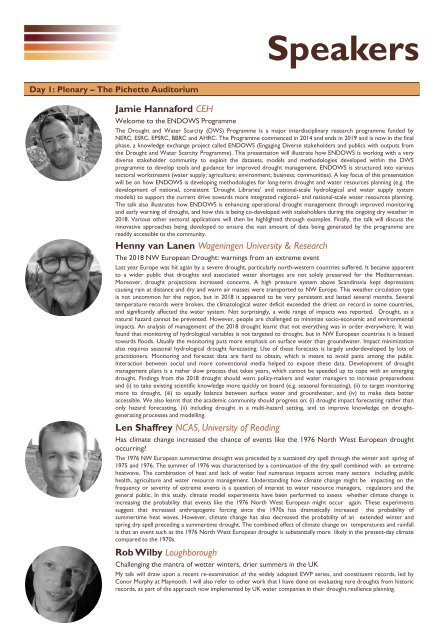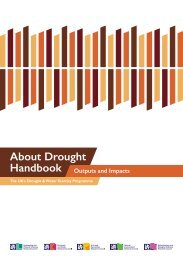DelegatePack_DroughtConference_20-21March2019
Create successful ePaper yourself
Turn your PDF publications into a flip-book with our unique Google optimized e-Paper software.
Speakers<br />
Day 1: Plenary – The Pichette Auditorium<br />
Jamie Hannaford CEH<br />
Welcome to the ENDOWS Programme<br />
The Drought and Water Scarcity (DWS) Programme is a major interdisciplinary research programme funded by<br />
NERC, ESRC, EPSRC, BBRC and AHRC. The Programme commenced in <strong>20</strong>14 and ends in <strong>20</strong>19 and is now in the final<br />
phase, a knowledge exchange project called ENDOWS (Engaging Diverse stakeholders and publics with outputs from<br />
the Drought and Water Scarcity Programme). This presentation will illustrate how ENDOWS is working with a very<br />
diverse stakeholder community to exploit the datasets, models and methodologies developed within the DWS<br />
programme to develop tools and guidance for improved drought management. ENDOWS is structured into various<br />
sectoral workstreams (water supply; agriculture; environment; business; communities). A key focus of this presentation<br />
will be on how ENDOWS is developing methodologies for long-term drought and water resources planning (e.g. the<br />
development of national, consistent ‘Drought Libraries’ and national-scale hydrological and water supply system<br />
models) to support the current drive towards more integrated regional- and national-scale water resources planning.<br />
The talk also illustrates how ENDOWS is enhancing operational drought management through improved monitoring<br />
and early warning of drought, and how this is being co-developed with stakeholders during the ongoing dry weather in<br />
<strong>20</strong>18. Various other sectoral applications will then be highlighted through examples. Finally, the talk will discuss the<br />
innovative approaches being developed to ensure the vast amount of data being generated by the programme are<br />
readily accessible to the community.<br />
Henny van Lanen Wageningen University & Research<br />
The <strong>20</strong>18 NW European Drought: warnings from an extreme event<br />
Last year Europe was hit again by a severe drought, particularly north-western countries suffered. It became apparent<br />
to a wider public that droughts and associated water shortages are not solely preserved for the Mediterranean.<br />
Moreover, drought projections increased concerns. A high pressure system above Scandinavia kept depressions<br />
causing rain at distance and dry and warm air masses were transported to NW Europe. This weather circulation type<br />
is not uncommon for the region, but in <strong>20</strong>18 it appeared to be very persistent and lasted several months. Several<br />
temperature records were broken, the climatological water deficit exceeded the driest on record in some countries,<br />
and significantly affected the water system. Not surprisingly, a wide range of impacts was reported. Drought, as a<br />
natural hazard cannot be prevented. However, people are challenged to minimize socio-economic and environmental<br />
impacts. An analysis of management of the <strong>20</strong>18 drought learnt that not everything was in order everywhere. It was<br />
found that monitoring of hydrological variables is not targeted to drought, but in NW European countries it is biased<br />
towards floods. Usually the monitoring puts more emphasis on surface water than groundwater. Impact minimization<br />
also requires seasonal hydrological drought forecasting. Use of these forecasts is largely underdeveloped by lots of<br />
practitioners. Monitoring and forecast data are hard to obtain, which is meant to avoid panic among the public.<br />
Interaction between social and more conventional media helped to expose these data. Development of drought<br />
management plans is a rather slow process that takes years, which cannot be speeded up to cope with an emerging<br />
drought. Findings from the <strong>20</strong>18 drought should warn policy-makers and water managers to increase preparedness<br />
and (i) to take existing scientific knowledge more quickly on board (e.g. seasonal forecasting), (ii) to target monitoring<br />
more to drought, (iii) to equally balance between surface water and groundwater, and (iv) to make data better<br />
accessible. We also learnt that the academic community should progress on: (i) drought impact forecasting rather than<br />
only hazard forecasting, (ii) including drought in a multi-hazard setting, and to improve knowledge on droughtgenerating<br />
processes and modelling.<br />
Len Shaffrey NCAS, University of Reading<br />
Has climate change increased the chance of events like the 1976 North West European drought<br />
occurring?<br />
The 1976 NW European summertime drought was preceded by a sustained dry spell through the winter and spring of<br />
1975 and 1976. The summer of 1976 was characterised by a continuation of the dry spell combined with an extreme<br />
heatwave. The combination of heat and lack of water had numerous impacts across many sectors including public<br />
health, agriculture and water resource management. Understanding how climate change might be impacting on the<br />
frequency or severity of extreme events is a question of interest to water resource managers, regulators and the<br />
general public. In this study, climate model experiments have been performed to assess whether climate change is<br />
increasing the probability that events like the 1976 North West European might occur again. These experiments<br />
suggest that increased anthropogenic forcing since the 1970s has dramatically increased the probability of<br />
summertime heat waves. However, climate change has also decreased the probability of an extended winter and<br />
spring dry spell preceding a summertime drought. The combined effect of climate change on temperatures and rainfall<br />
is that an event such as the 1976 North West European drought is substantially more likely in the present-day climate<br />
compared to the 1970s.<br />
Rob Wilby Loughborough<br />
Challenging the mantra of wetter winters, drier summers in the UK<br />
My talk will draw upon a recent re-examination of the widely adopted EWP series, and constituent records, led by<br />
Conor Murphy at Maynooth. I will also refer to other work that I have done on evaluating rare droughts from historic<br />
records, as part of the approach now implemented by UK water companies in their drought resilience planning.




